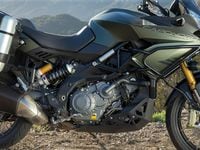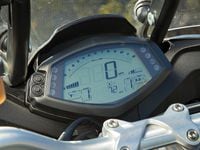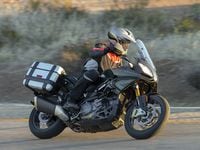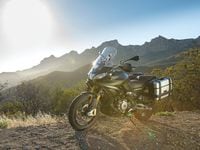THEY SAY: "The perfect bike for traveling." WE SAY: "In smooth comfort, especially."
When we first clapped orbs on the Aprilia Caponord, the current generation that debuted in 2014 (see the 2014 First Ride here), what we saw was a rakishly designed bike we came to describe as a "crossover" ADV—not GS rugged but more like a Multistrada alternative: seductive, well proportioned, promising high performance in a comfortable, all-day package. Sure, it had adventure-tourer pretensions but with a streetbike's soft underbelly. Soft, too, was the bike's innovative Aprilia Dynamic Damping, which gave it a magic-carpet ride but cut short its ability to charge canyons. What, exactly, was it trying to be?
Now there’s the Caponord Rally. On the Capo’s basic platform swap cast-aluminum wheels with a spoke design that allows for tubeless tires. (They’re similar to the ones used on the first-generation V-twin Caponord.) Change sizes while you’re at it, from the streetbike-conventional 120/70-17 and 180/55-17 combo to the sizes preferred by the modern ADVs: a 120/17-19 front and a 170/60-17 rear. These sizes provide access to the latest heavy dual-sport tires, from real knobbies to what are really just heavily treaded sport-touring skins. Chassis geometry gets a tweak as well, with slightly more rake (27.4 versus 26.1 degrees) and less trail (4.6 versus 4.9 inches), the latter accomplished by pushing the axle out ahead of the fork centerline. Suspension travel remains the same, while seat height is up just 0.1 inch, to 33.1 inches.
In keeping with the Rally theme, the latest Caponord gets a “crashbar” fairing protector (a great place to put fog lights), an underbelly pan, and a taller (but still easily adjustable) windscreen. The Capo Rally also switches from street-oriented hard luggage to standard Givi-built, Aprilia-badged Trekkers. At 33 liters a side, the Capo gains 4 liters per flank and the Trekkers’ unique semi-top-loading design; you can open them like a regular side-firing clamshell or gain access to your stuff through an opening slot in the top, outer edge.
There are no changes to the Aprilia 90-degree V-twin. This time, the 1,197cc, four-valve-per engine put down 109.1 hp and 73 pound-feet of torque, better than the last one we tested and within 2 hp of the class-standard R1200GS, though the BMW out-torques the Aprilia by 8.4 pound-feet. For the Capo, torque off the bottom is good, and there's a nice top-third lunge up to the 9,000-rpm redline, but the midrange feels a little uninspired. Tall gearing hurts some, as does the Capo's full-of-fuel weight of 612 pounds, including the bags, a gain of 22 pounds over the cast-wheel Capo we tested in 2014.
On the road, though, the Aprilia Caponord moves along smartly and responds as you'd want it to, accompanied by a lovely howl from the intake and a bark from the valve-aided exhaust system. Of the three ride modes—Sport, Touring, and Rain—we prefer the more predicable responses in Touring. Sport is lumpier and more aggressive than necessary in a comfort-first machine. Generally, though, the ride-by-wire responses are fine, and the traction control stays out of your way during spirited street riding. As long as it's on the minimum setting, that is.
And that's what this Capo continues to be: a super-smooth distance muncher. That new windscreen works beautifully, giving excellent protection with minimal turbulence, and the combination of a soft seat and plentiful legroom creates a cockpit you won't cramp out of before the first stop. Handling, now that it's wearing a 19-inch front, is also more in line with the idea of a tall sport-tourer. Initial tip-in is good, though the bike is noticeably slower from, say, 30 degrees left to 30 degrees right. (It's about the same the other way; we checked.) Perhaps as a result of the narrower rear tire, the Capo is completely neutral midcorner. Let go of the bar and it'll happily carve the same radius all day long. In a lot of ways, the bike's more relaxed handling better fits the kind of bike the styling promises.
About the Aprilia suspension. Supposedly there are no changes to the electronic damping schedules. But we swear we can feel stiffer damping in most regimes. Our Rally was much less likely to drag footpegs and hard underbits than before. Remember that there are no damping adjustments for the rider to make. The ADD watches myriad inputs—throttle position, degree of braking, chassis pitch and yaw—and determines the ideal amount of damping. No associated ride modes either; the damping schedule is meant to be adaptive rather than carrying a set of preconceived settings based on ride mode or rider-determined damping skews. Simpler, for sure. Set and forget. Still, for whatever reason, the Rally feels firmer than the last Caponord we tested but still very compliant, and that's a good thing.
Long-haul performance remains unaffected. Plant yourself on the soft saddle, stretch out to the rubber-covered pegs, reach for the almost-too-wide aluminum bar, and stare at the horizon. The Capo is ready to take you there, striding on average 37 miles from each of the 6.3 gallons between your knees—for around 230 miles of range without reserve—and taking care of your frazzled nerves with tall gearing and a quiet, smooth engine. A prodigious amount of heat from the exhaust components ahead of the swingarm is the only serious blemish.
The previous Caponord set itself apart as a terrific value. Still the case: $15,699, a $200 bump over the base Capo, gets you a complete touring rig—hard side luggage with matched-key locking, tubeless cross-spoke wheels, bash guard, full electronic instrumentation, and fog lights. Heated grips are an option. Oh, and cruise control, though the one-button scheme—it's on or off, no incremental adjustments—is pretty rudimentary.
Where do we end up on the whole identity thing, then? Actually, a lot more resolved. If you accept that the core ADV machines are softer and broader focused than similarly sized sport-touring machines, then Rally-ifying the Caponord makes perfect sense. Now its styling better fits the bike’s intrinsic personality. It’s not intended to clip apexes with a Multistrada or a BMW XR. Nor is it meant to really do much off-roading, like a BMW R1200GS Adventure or KTM 1190 Adventure R. Somehow, with the ADV-size spoke wheels and less-sportbike styling, the new Rally seems to have found its place.

















/cloudfront-us-east-1.images.arcpublishing.com/octane/MUQLOVLL2ZDGFH25ILABNBXKTI.jpg)
/cloudfront-us-east-1.images.arcpublishing.com/octane/TNOU5DNE2BC57MFPMGN2EIDXAM.jpg)
/cloudfront-us-east-1.images.arcpublishing.com/octane/GTCXACQGJ5HAPDTGWUQKDEH44E.jpg)
/cloudfront-us-east-1.images.arcpublishing.com/octane/S35YGSEMEZB4BLTDJTSZPF4GLA.jpg)
/cloudfront-us-east-1.images.arcpublishing.com/octane/5UOT6HPX2JFMRJAX6EH45AR4MQ.jpg)
/cloudfront-us-east-1.images.arcpublishing.com/octane/OKWOJWAKP5EP3OACCRRWPCIX2Q.jpg)
/cloudfront-us-east-1.images.arcpublishing.com/octane/2WF3SCE3NFBQXLDNJM7KMXA45E.jpg)
/cloudfront-us-east-1.images.arcpublishing.com/octane/G4MG6OUCJNBSHIS2MVVOTPX65E.jpg)
/cloudfront-us-east-1.images.arcpublishing.com/octane/IIGGWFOTOJGB7DB6DGBXCCMTDY.jpg)
/cloudfront-us-east-1.images.arcpublishing.com/octane/QSTCM6AVEZA5JJBUXNIQ3DSOF4.jpg)
/cloudfront-us-east-1.images.arcpublishing.com/octane/U4I7G625B5DMLF2DVIJDFZVV6M.jpg)
/cloudfront-us-east-1.images.arcpublishing.com/octane/B6XD6LS6IVCQPIU6HXDJSM3FHY.jpg)
/cloudfront-us-east-1.images.arcpublishing.com/octane/ICL63FEDDRDTTMINYICCEYGMDA.jpg)
/cloudfront-us-east-1.images.arcpublishing.com/octane/FCGZHQXRBZFLBAPC5SDIQLVF4I.jpg)
/cloudfront-us-east-1.images.arcpublishing.com/octane/WNOB6LDOIFFHJKPSVIWDYUGOPM.jpg)

/cloudfront-us-east-1.images.arcpublishing.com/octane/X33NU3E525ECRHXLNUJN2FTRKI.jpg)
/cloudfront-us-east-1.images.arcpublishing.com/octane/6KKT5NNL2JAVBOXMZYS5ZO76YA.jpg)
/cloudfront-us-east-1.images.arcpublishing.com/octane/J5RKG5O455GMPGQRF2OG6LRT7A.jpg)
/cloudfront-us-east-1.images.arcpublishing.com/octane/GX2CIZKQVRH2TATDM26KFG2DAE.jpg)
/cloudfront-us-east-1.images.arcpublishing.com/octane/ZWIDYSAKQZHD5BHREMQILXJCGM.jpg)
/cloudfront-us-east-1.images.arcpublishing.com/octane/CYUHJZCTSJCH3MRAQEIKXK7SCQ.jpg)
/cloudfront-us-east-1.images.arcpublishing.com/octane/LKOFINY56FCXJCANJ5M7ZDQUBY.jpg)
/cloudfront-us-east-1.images.arcpublishing.com/octane/4NBPDACMWJH63JQYJVK3QRBDZI.jpg)